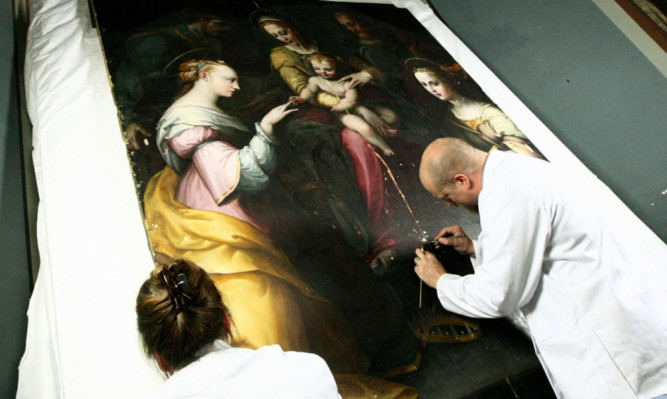Painstaking work to restore a masterpiece once thought to be the work of Michelangelo has left Falkland Palace “spellbound”.
Conservationists have been working on the restoration of The Mystic Marriage of St Catherine of Alexandria with St Apollonia, St Joseph and St John the Evangelist in situ in the Fife palace.
Due to the size and weight of the painting, by Italian renaissance painter Francesco Brini, it has been treated not in a workshop but in a special area built in the chapel.
Expert painting conservators Gail Egan and Henry Matthews from Egan, Matthews and Rose have been working over the last week.
The project to conserve the important 16th Century painting at the National Trust for Scotland’s property has captured the imagination of all those who have been watching the intricate work.
Over the last few weeks, conservators have been carefully removing layers of discoloured varnish and dirt to reveal the true colours of the painting.
This painstaking process is revealing a great deal.
Wendy Purvis, property manager at the palace said: “I’ve been spellbound by the process, which has revealed the original paint.
“How fascinating it is to watch conservators at work and learn about the process as it happens live.
“This is the sort of thing that would normally happen behind closed doors but to see it every day is a real privilege.”
Work is revealing the true colours and extra detail in the painting what was thought to be pale green is a powder blue, while dirty orange is revealed as bright gold.
Extra detail lost under the centuries of varnish is being rediscovered, such as the tiny face on the front of St Apollonia’s dress and the delicate veil on her hair.
A technical analysis of the paint layers by Glasgow University’s department of technical art history has identified pigments commonly used in the 15th and 16th Centuries, as the trust had hoped to find.
Understanding the composition of the painting’s structure will greatly help the conservators in deciding the most appropriate treatment to be carried out on the picture.
Trust conservator Julie Bon said: “It has been exciting to be involved in this unique project.”
